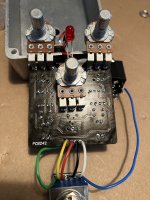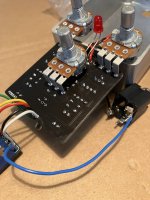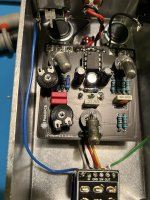ReinoutVrijhoef
Member
Hi everybody,
I'm quite new to pedal building, the Soul Vendor is my 8th endeavour. The behaviour of the pedal is not as I expected, so I would like to ask you for help. You can watch and hear the pedal on Youtube:
I recorded the video with a Strat in the bridge position running into a Kemper with a fairly clean profile of a Marshall Bluesbreaker, like, why not? The input on the Kemper isn't clipping, and the pedal behaves just the same on my tube amps.
I bought this pedal in a kit from Musikding, including a special set of AC125's, matched for a ToneBender mk3. The battery is running on 9.32V, the temperature is on room temperature (19°C, 66°F) and the humidity is about 57%. I haven't checked the hfe myself, because my cheap multimeter is being an *ss about it.
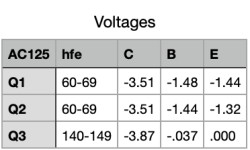
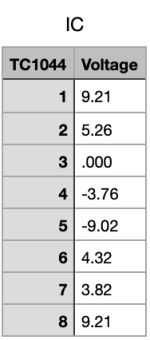
My circuit looks like this, you can find the schematic here.
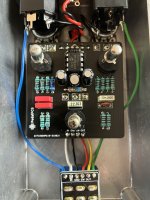
If you can help me fixing this pedal, I would be very grateful. I can't seem to find the "right" voltages for the germanium transistors. I already built the Analog Sun (PCB Mania) which sounds great! Also the Rift (Aion) is a great sounding fuzz. Any help is greatly appreciated!
I'm quite new to pedal building, the Soul Vendor is my 8th endeavour. The behaviour of the pedal is not as I expected, so I would like to ask you for help. You can watch and hear the pedal on Youtube:
I recorded the video with a Strat in the bridge position running into a Kemper with a fairly clean profile of a Marshall Bluesbreaker, like, why not? The input on the Kemper isn't clipping, and the pedal behaves just the same on my tube amps.
I bought this pedal in a kit from Musikding, including a special set of AC125's, matched for a ToneBender mk3. The battery is running on 9.32V, the temperature is on room temperature (19°C, 66°F) and the humidity is about 57%. I haven't checked the hfe myself, because my cheap multimeter is being an *ss about it.


My circuit looks like this, you can find the schematic here.

If you can help me fixing this pedal, I would be very grateful. I can't seem to find the "right" voltages for the germanium transistors. I already built the Analog Sun (PCB Mania) which sounds great! Also the Rift (Aion) is a great sounding fuzz. Any help is greatly appreciated!



